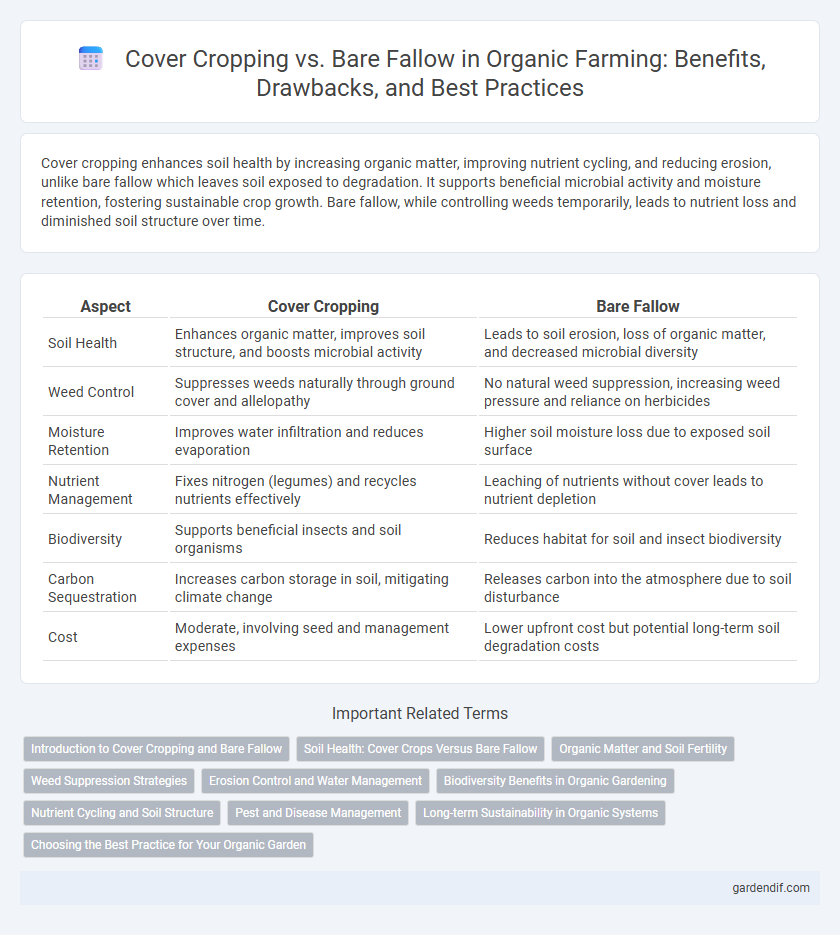
Cover cropping vs bare fallow Illustration
Cover cropping enhances soil health by increasing organic matter, improving nutrient cycling, and reducing erosion, unlike bare fallow which leaves soil exposed to degradation. It supports beneficial microbial activity and moisture retention, fostering sustainable crop growth. Bare fallow, while controlling weeds temporarily, leads to nutrient loss and diminished soil structure over time.
Table of Comparison
| Aspect | Cover Cropping | Bare Fallow |
|---|---|---|
| Soil Health | Enhances organic matter, improves soil structure, and boosts microbial activity | Leads to soil erosion, loss of organic matter, and decreased microbial diversity |
| Weed Control | Suppresses weeds naturally through ground cover and allelopathy | No natural weed suppression, increasing weed pressure and reliance on herbicides |
| Moisture Retention | Improves water infiltration and reduces evaporation | Higher soil moisture loss due to exposed soil surface |
| Nutrient Management | Fixes nitrogen (legumes) and recycles nutrients effectively | Leaching of nutrients without cover leads to nutrient depletion |
| Biodiversity | Supports beneficial insects and soil organisms | Reduces habitat for soil and insect biodiversity |
| Carbon Sequestration | Increases carbon storage in soil, mitigating climate change | Releases carbon into the atmosphere due to soil disturbance |
| Cost | Moderate, involving seed and management expenses | Lower upfront cost but potential long-term soil degradation costs |
Introduction to Cover Cropping and Bare Fallow
Cover cropping involves planting specific crops during off-season periods to improve soil health, enhance nutrient cycling, and reduce erosion. Bare fallow refers to leaving soil uncultivated and unplanted, which can lead to increased soil erosion, nutrient depletion, and diminished microbial activity. Incorporating cover crops contributes to sustainable farming by maintaining soil structure and fertility, while bare fallow often requires additional inputs to restore soil quality.
Soil Health: Cover Crops Versus Bare Fallow
Cover cropping significantly enhances soil health by increasing organic matter, improving soil structure, and promoting beneficial microbial activity compared to bare fallow. The presence of cover crops reduces erosion, conserves moisture, and suppresses weeds, leading to more resilient and fertile soil ecosystems. In contrast, bare fallow often results in soil degradation, loss of nutrients, and diminished microbial diversity.
Organic Matter and Soil Fertility
Cover cropping significantly enhances organic matter content by adding biomass and root residues to the soil, which improves soil structure and nutrient retention. Bare fallow practices lead to the depletion of organic matter, resulting in reduced microbial activity and lower soil fertility over time. Incorporating cover crops like legumes or grasses promotes nitrogen fixation and increases soil organic carbon, boosting overall soil health and productivity in organic farming systems.
Weed Suppression Strategies
Cover cropping enhances weed suppression by creating a competitive environment that limits weed seed germination and growth, reducing reliance on herbicides. Diverse cover crop species such as rye, clover, and buckwheat provide allelopathic effects and physical barriers, effectively inhibiting weed establishment. In contrast, bare fallow leaves soil exposed, allowing weed seeds to germinate freely, often necessitating repeated mechanical or chemical control measures.
Erosion Control and Water Management
Cover cropping significantly reduces soil erosion by protecting the soil surface from raindrop impact and runoff, enhancing soil structure and organic matter content. Bare fallow leaves soil exposed, increasing vulnerability to erosion and reducing water infiltration and retention capacity. By maintaining continuous plant cover, cover crops improve water management through better moisture retention and enhanced soil porosity, supporting sustainable organic farming practices.
Biodiversity Benefits in Organic Gardening
Cover cropping significantly enhances biodiversity in organic gardening by providing habitat for beneficial insects, soil microorganisms, and earthworms, which improve soil health and nutrient cycling. Unlike bare fallow, cover crops reduce soil erosion, increase organic matter, and suppress weeds naturally, fostering a more resilient and diverse agroecosystem. This biodiversity boost leads to improved pest control and pollination, essential components for sustainable organic crop production.
Nutrient Cycling and Soil Structure
Cover cropping significantly enhances nutrient cycling by fixing atmospheric nitrogen, increasing organic matter, and promoting microbial activity, which improves soil fertility compared to bare fallow. The root systems of cover crops help maintain soil structure by reducing erosion, increasing porosity, and enhancing water retention, while bare fallow soils often suffer compaction and nutrient depletion. Incorporating cover crops into organic farming practices supports sustainable soil health and long-term productivity.
Pest and Disease Management
Cover cropping enhances pest and disease management by promoting beneficial insect populations and disrupting pest life cycles, reducing reliance on chemical pesticides. Bare fallow leaves soil exposed, increasing vulnerability to soil-borne diseases and pest buildup due to lack of biological activity. Implementing cover crops like legumes or grasses fosters a healthy soil ecosystem that suppresses pathogens and improves crop resilience.
Long-term Sustainability in Organic Systems
Cover cropping enhances long-term sustainability in organic systems by improving soil structure, increasing organic matter, and promoting biodiversity compared to bare fallow practices. Soil erosion and nutrient depletion are significantly reduced with cover crops, which support microbial activity and natural pest control. Maintaining protective vegetation year-round fosters resilient ecosystems and sustainable yields in organic farming.
Choosing the Best Practice for Your Organic Garden
Cover cropping enhances soil fertility by adding organic matter, improving nutrient cycling, and suppressing weeds more effectively than bare fallow. Bare fallow, while reducing weed pressure temporarily, risks soil erosion and nutrient depletion without protective plant cover. Selecting cover crops like clover or rye supports soil health and biodiversity, making it the preferred organic garden practice for sustainable productivity.
Cover cropping vs bare fallow Infographic

 gardendif.com
gardendif.com